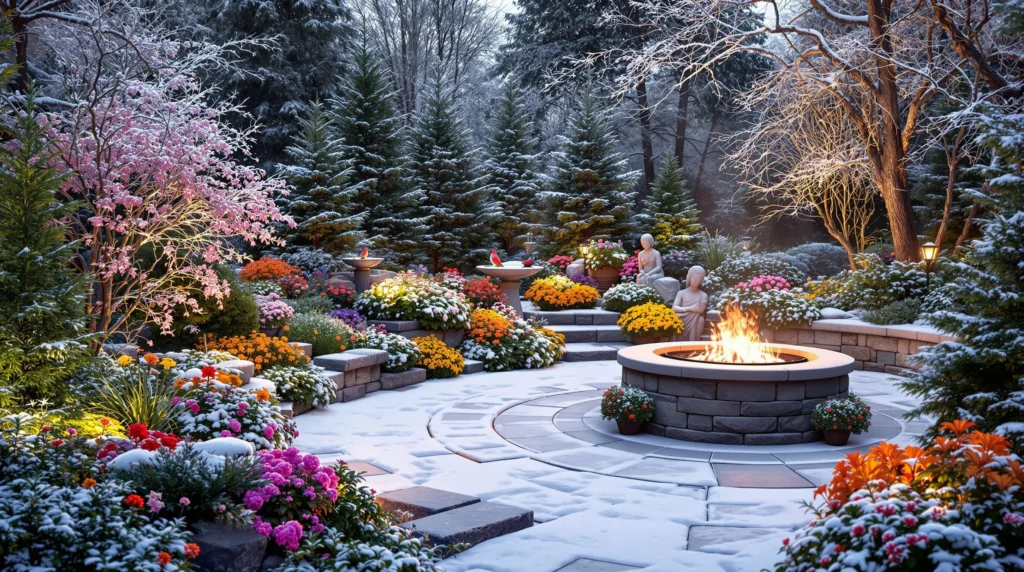10 Winter Garden Ideas to Transform Your Cold-Weather Landscape
- Plant Winter-Blooming Flowers – Brighten your winter garden with cold-hardy bloomers like hellebores, winter jasmine, and witch hazel. These resilient plants offer vibrant colors when most gardens lie dormant, creating unexpected pops of interest throughout the coldest months.
- Create a Winter Container Garden – Arrange frost-resistant plants in decorative containers to add portable beauty to your winter industry. Combine dwarf evergreens, ornamental cabbages, and colorful stems like red-twig dogwood for instant visual impact that can be repositioned as needed.
- Install Strategic Lighting – Transform your winter garden with thoughtfully placed outdoor lighting. Solar path lights, string lights in trees, or spotlights highlighting interesting plant structures will extend your garden’s enjoyment into the evening hours and showcase snow and frost formations.
- Incorporate Sculptural Elements – Add architectural interest with garden sculptures, ornate trellises, or artistic metalwork that stands out against the winter backdrop. These permanent features become focal points when plants recede, adding structure and personality to bare winter landscapes.
- Build a Winter Bird Sanctuary – Attract colorful winter birds by installing feeders, bird baths with heaters, and protective shelters. Birds bring movement, color, and life to winter gardens while helping with pest control throughout the year.
- Design a Winter Herb Garden – Grow cold-tolerant herbs like rosemary, thyme, and sage in protected areas near your home. Many Mediterranean herbs are surprisingly resilient and will provide fresh flavors for winter cooking while maintaining attractive foliage.
- Create Colorful Bark Displays – Plant trees and shrubs known for interesting bark like paperbark maple, river birch, or red-twig dogwood. Their distinctive textures and colors become prominent visual features when leaves have fallen, adding dimension to winter landscapes.
- Build Raised Beds with Cold Frames – Extend your growing season with raised beds topped with cold frames or hoop houses. These structures create microenvironments where you can grow cool-season vegetables like kale, spinach, and carrots throughout winter in many climates.
- Design a Winter Rock Garden – Incorporate various sized stones and boulders to create structural interest that snow and frost will highlight beautifully. Pair with compact evergreens and ornamental grasses for a low-maintenance winter display with natural appeal.
- Add a Fire Feature – Install a fire pit, outdoor fireplace, or chiminea to create a cozy gathering spot in your winter garden. Beyond providing warmth, fire features create an inviting focal point that encourages outdoor enjoyment even on the coldest days.
Creating a Winter Vegetable Garden: Crops That Thrive in Cold Weather

Don’t let winter put a stop to your vegetable gardening ambitions. With the right cold-hardy crops and techniques, you can harvest fresh vegetables even during the coldest months of the year. Many vegetables actually prefer cooler temperatures and can survive light frosts or even hard freezes with proper protection.
Cold-Hardy Vegetables to Plant in Winter
Winter vegetable gardens can be surprisingly productive with the right crop selection. Leafy greens like kale, spinach, and collards thrive in cold weather and often taste sweeter after frost exposure due to their increased sugar content. Root vegetables such as carrots, turnips, and parsnips can remain in the ground throughout winter in many regions, acting as natural cold storage while continuing to develop flavor. Brussels sprouts and cabbage become stars of the winter garden, developing best during cool temperatures. Garlic and onions can be planted in fall for a head start on spring growth, developing strong root systems during winter. Cold-tolerant herbs including rosemary, sage, and thyme provide fresh flavors all season long. For areas with milder winters, try growing snow peas, which can tolerate light frosts and provide sweet harvests during winter months.
Winter Gardening Techniques for Maximum Yield
Success with winter vegetables requires exact techniques to protect plants and extend harvests. Apply a thick layer of mulch (3-4 inches) around plants to insulate soil, regulate temperature fluctuations, and protect roots from freezing. Install row covers or cold frames to create mini-greenhouses that trap heat while allowing light penetration, raising temperatures by 5-10°F. Time your plantings carefully—start cold-hardy crops 6-8 weeks before your first expected frost to establish strong root systems. Consider using raised beds which warm faster in spring and provide better drainage during wet winter months. Water plants judiciously in the morning to allow foliage to dry before evening temperature drops, preventing frost damage. Harvest vegetables during the warmest part of the day when plants are less brittle. For extreme weather protection, layer your defenses with combinations of mulch, row covers, and cold frames to create multiple barriers against freezing temperatures.
Decorative Winter Container Gardens for Porches and Patios
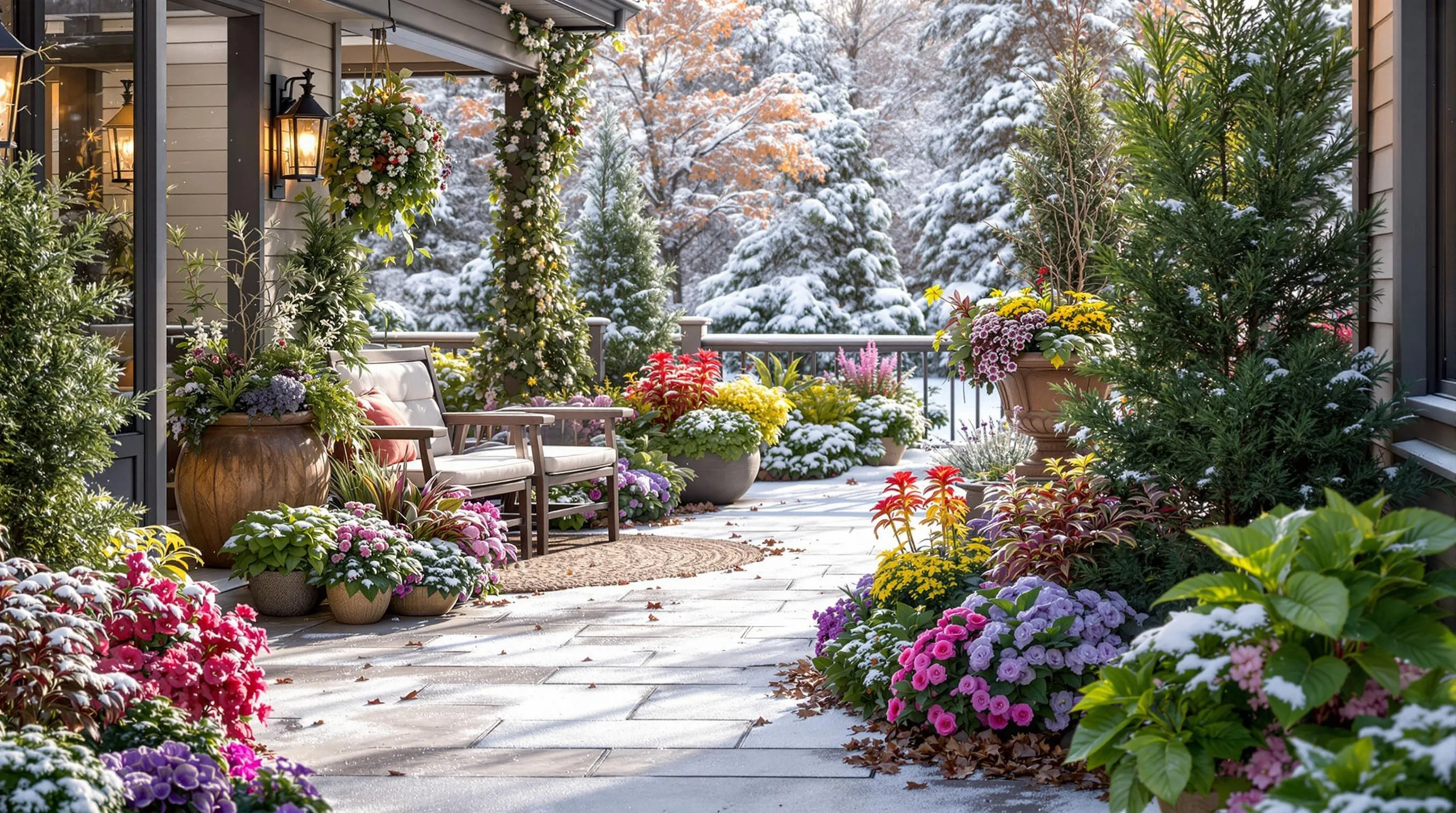
Container gardens offer a versatile way to bring winter beauty to your outdoor living spaces without committing to in-ground plantings. These portable displays can transform bare porches and patios into welcoming winter landscapes with minimal effort.
Evergreen Arrangements That Last All Season
Create stunning evergreen container gardens that provide months of interest with minimal maintenance. Start with a mix of dwarf conifers like blue spruce, juniper, or arborvitae as your foundation plants. Add texture with broadleaf evergreens such as holly, boxwood, or euonymus. For visual interest, incorporate plants with different heights—place taller elements in the center or back, with cascading varieties like ivy or vinca spilling over the edges. Choose frost-resistant containers made from fiberglass, resin, or thick concrete that won’t crack in freezing temperatures. Remember to water these containers occasionally during winter thaws, as evergreens continue to transpire moisture even in cold weather.
Colorful Winter Container Combinations
Brighten winter days with containers that feature bold colors and interesting textures. Combine red-twig dogwood branches with silvery dusty miller, purple heuchera, and golden creeping jenny for a stunning color palette. Add winter-blooming plants like hellebores, winter pansies, or cyclamen in protected areas for unexpected floral accents. Ornamental kale and cabbage provide sculptural forms with their rosettes of purple, pink, and white. Berried plants such as winterberry holly or beautyberry contribute vibrant pops of color that persist through winter storms. For instant impact, incorporate seasonal elements like pinecones, birch branches, or preserved seedheads from summer perennials. These colorful combinations can be refreshed throughout the season by swapping out faded components with fresh elements as needed.
Installing Winter Garden Lighting to Enhance Dark Days

Winter’s shorter days don’t have to limit your garden enjoyment. Strategic lighting transforms your winter garden into a magical nighttime retreat while highlighting your garden’s best features during the darkest months.
Solar Options for Eco-Friendly Winter Illumination
Solar lighting offers a sustainable way to illuminate your winter garden without increasing your energy bills. Modern solar lights collect enough energy even on cloudy winter days to provide several hours of evening illumination. Place solar path lights along walkways to ensure safe navigation while adding a warm glow to your industry. Solar spotlights can highlight specimen plants, sculptural elements, or water features with dramatic effect. For trees with interesting bark or structure, consider solar uplights positioned at the base to create striking silhouettes against the night sky. Most quality solar lights now include rechargeable batteries that store power efficiently even in cold temperatures, though you’ll want to position solar panels in areas that receive maximum winter sunlight for optimal performance.
Creating Magical Light Displays Among Plants
Transform your winter garden into an enchanting nighttime wonderland by weaving string lights through branches, shrubs, and evergreen plants. Warm white LED lights wrapped around tree trunks and extending into branches create a starry effect that’s both elegant and festive. For dramatic impact, use spotlights with colored filters to cast blue or purple hues on white-barked trees like birches or light-colored garden structures. Consider installing weatherproof strip lighting beneath benches or along the edges of raised beds to create floating effects in the darkness. Motion-sensor lights serve both security and aesthetic purposes, illuminating garden paths when you venture outdoors while creating surprising moments of beauty. For special occasions, portable battery-operated lanterns placed strategically among plants can create intimate gathering spaces even in the coldest months, extending your garden enjoyment well into the evening hours.
Winter Bird-Friendly Garden Features to Attract Wildlife
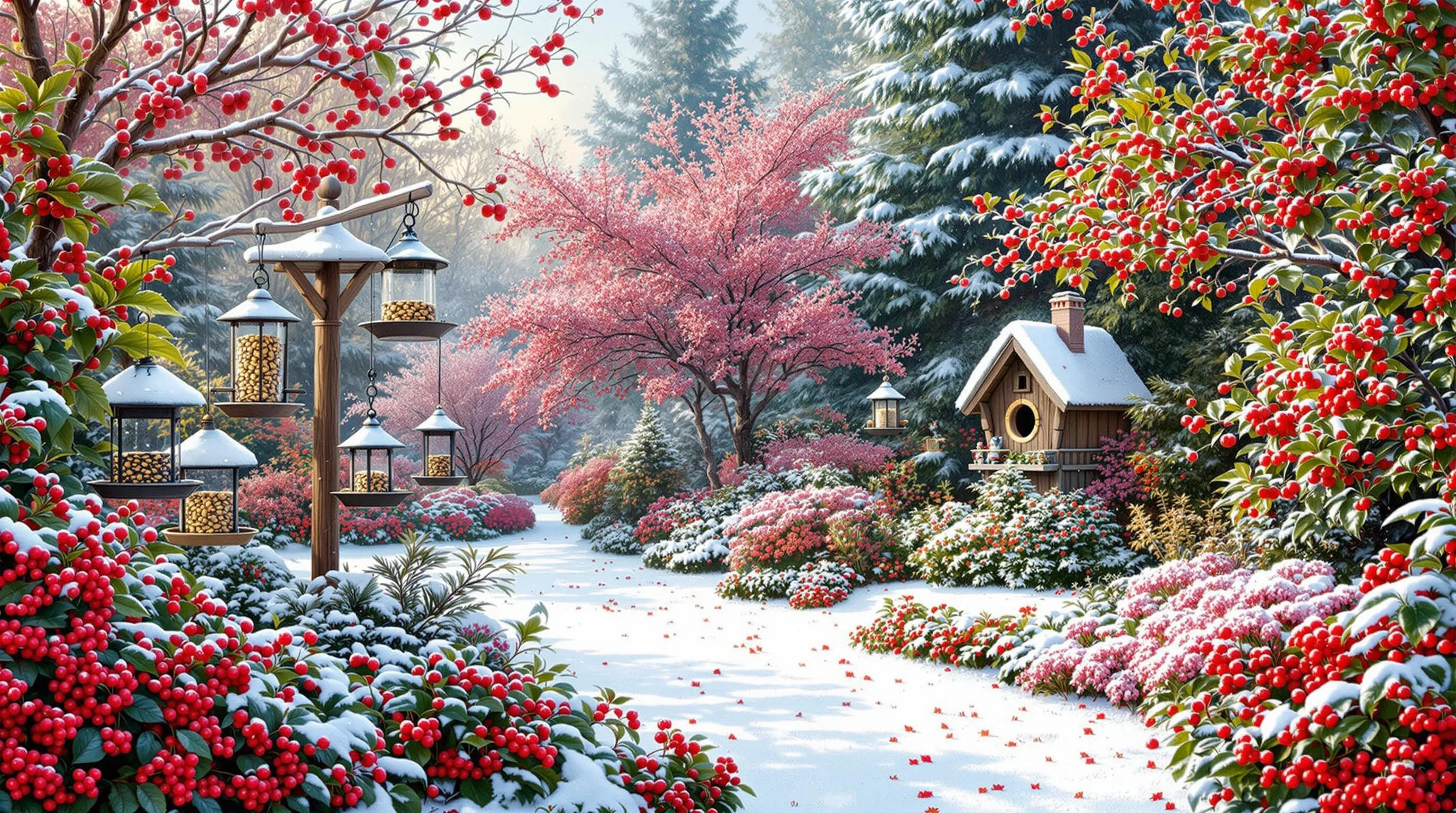
Transform your winter garden into a haven for birds and wildlife with thoughtful features that provide food and shelter during the harshest months. When your flowering plants have faded and the industry appears dormant, wildlife activity can bring your garden back to life with movement and color.
Bird Feeding Stations and Natural Food Sources
Set up strategic feeding stations throughout your garden to attract a variety of bird species during winter. Install multiple feeder types—tube feeders for finches, platform feeders for cardinals, and suet cages for woodpeckers—to accommodate different feeding preferences. Fill them with high-energy foods like black oil sunflower seeds, nyjer seeds, and suet, which provide essential calories birds need to maintain body heat in cold temperatures. Position your feeders near shrubs or trees (about 10-15 feet away) to offer quick escape routes from predators while keeping them visible from your windows for optimal viewing. Beyond traditional feeders, incorporate natural food sources by planting berry-producing shrubs like winterberry holly, crabapple trees, and native viburnums that retain their fruits through winter. These natural buffets not only provide essential nutrition but also add striking visual elements to your winter industry with their bright berries against the snow.
Creating Shelter for Winter Wildlife
Provide critical winter protection by creating diverse shelter options throughout your garden. Leave sections of ornamental grasses uncut to offer insulation and hiding spots for small creatures like rabbits and beneficial insects. Install roosting boxes specifically designed with smaller entrances and thicker walls than nesting boxes to help birds conserve body heat on frigid nights. Create brush piles in quiet corners of your yard using fallen branches and pruned limbs—these simple structures serve as multi-purpose shelters for birds, small mammals, and hibernating insects. Maintain dense evergreen shrubs and trees like arborvitae, spruce, and juniper that block harsh winds and provide protective cover from both weather and predators. Consider adding a heated bird bath maintained at about 40°F to provide crucial drinking water when natural sources freeze, positioning it near shelter but away from feeding stations to prevent contamination. These thoughtful additions not only support local wildlife survival but also create captivating opportunities for winter wildlife watching from the comfort of your home.
Winter Pruning Projects to Prepare for Spring Growth
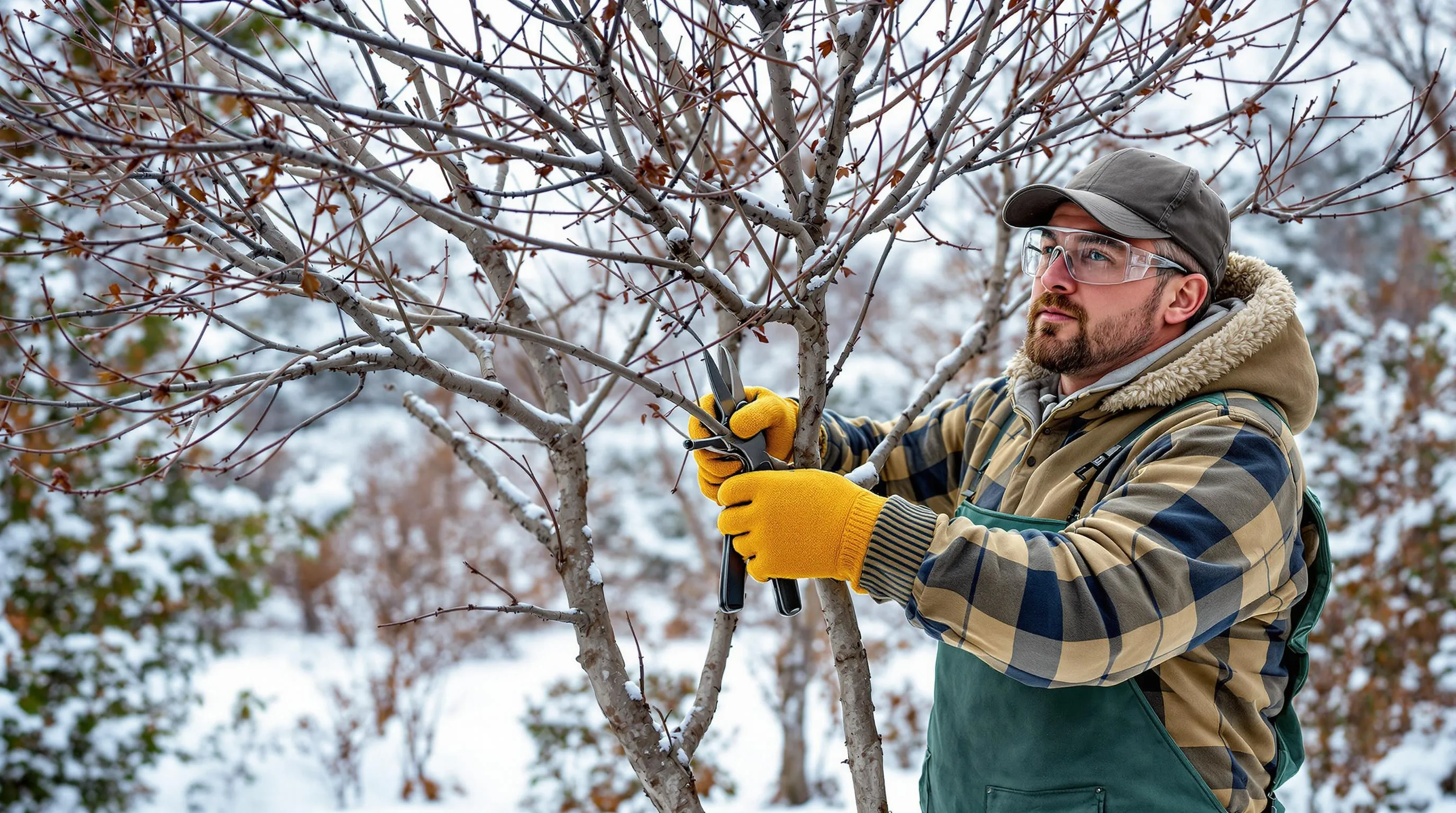
Winter is the perfect time to tackle pruning projects while plants are dormant. Strategic winter pruning not only shapes your garden but also promotes vigorous growth when spring arrives.
Dormant Season Pruning Techniques
Winter pruning provides unique advantages for many plants in your garden. Focus on deciduous trees and shrubs after they’ve dropped their leaves for better visibility of the branch structure. Remove dead, diseased, or crossing branches first, making clean cuts at a 45-degree angle just above outward-facing buds. Thin out dense growth to improve air circulation, which helps prevent disease in the coming growing season. For fruit trees, winter pruning increases productivity by removing unproductive branches and directing energy to fruit-bearing limbs. Roses benefit from winter pruning too—cut back hybrid teas by one-third to one-half their height, and remove any spindly growth. Wait until late winter to prune spring-flowering shrubs like forsythia and lilac, as early pruning will remove flower buds and reduce spring displays.
Tools and Tips for Winter Tree Care
Equip yourself with high-quality pruning tools for efficient winter maintenance. Sharp bypass pruners work best for branches under ½ inch, while loppers handle branches up to 2 inches thick. For larger limbs, use a pruning saw with clean, sharp teeth. Always disinfect your tools between plants with a 10% bleach solution or rubbing alcohol to prevent disease spread. Protect yourself with thick gloves and safety glasses, especially when working with thorny plants or overhead branches. Avoid pruning during freezing temperatures, as this can damage plant tissue; instead, choose a mild day above freezing. Apply pruning sealer only on oak trees in areas prone to oak wilt disease—most trees heal naturally without sealers. Finally, create a pruning calendar that identifies which plants need attention in early, mid, or late winter to maximize your garden’s spring potential and minimize unnecessary work.
Protecting Sensitive Plants from Frost and Freezing Temperatures
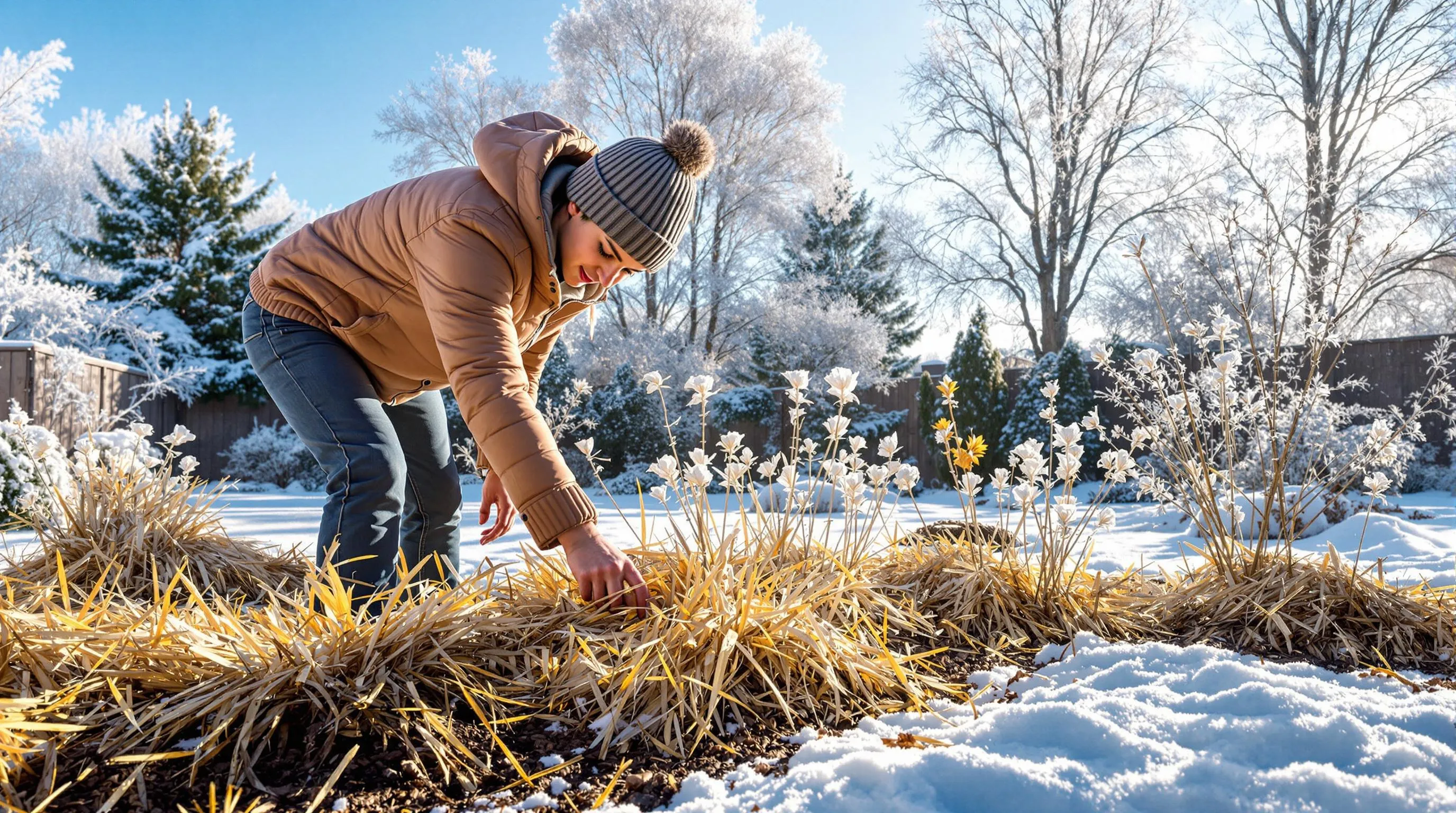
As winter approaches, protecting your tender plants from frost and freezing temperatures becomes essential for maintaining a thriving garden. With the right strategies, you can shield your vulnerable plants from cold damage and ensure they survive until spring.
Winter Mulching Strategies
Winter mulching is your first line of defense against freezing temperatures. Apply a 3-4 inch layer of organic mulch around sensitive plants after the first hard frost to insulate soil and protect roots. Opt for materials like straw, pine needles, shredded leaves, or bark chips that trap air and provide excellent insulation. Keep mulch slightly away from plant stems to prevent rot and rodent damage. For perennial beds, wait until the ground freezes before applying mulch to discourage pests from nesting. Extend your mulching to container plants by wrapping pots with bubble wrap or burlap before adding a top layer of mulch. Remember to remove heavy mulch gradually in spring to avoid shocking plants with sudden temperature changes.
Coverings and Structures for Plant Protection
Temporary coverings offer immediate protection when frost threatens your garden. Use frost cloths, old bedsheets, or specialized plant blankets to create protective barriers around sensitive plants before nightfall, removing them in the morning to allow sunlight and air circulation. For more permanent answers, install cold frames or mini-greenhouses over vegetable beds to trap heat while allowing light penetration. Hoop houses covered with clear plastic create microclimate zones that can be 5-10°F warmer than surrounding areas. For individual plants, try placing upturned pots, buckets, or commercial cloches over tender specimens overnight. Water plants thoroughly before covering as moist soil retains heat better than dry soil. Enhance protection by placing jugs filled with warm water near plants under covers to release heat throughout the night, creating a simple but effective temperature buffer for your most valuable garden specimens.
Winter Garden Structures That Add Visual Interest
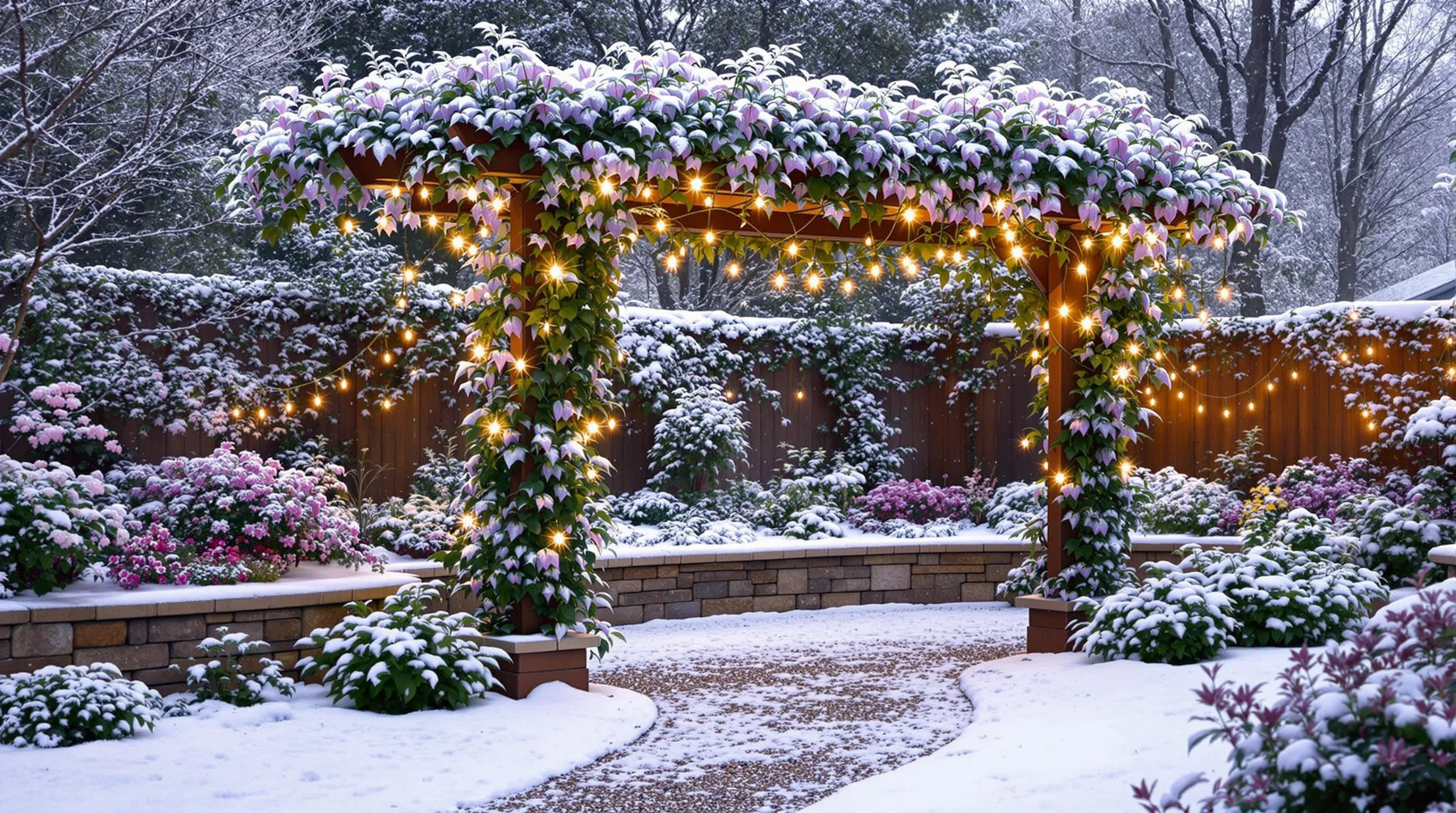
Decorative Trellises and Arbors for Winter Appeal
Decorative trellises and arbors transform winter gardens into architectural showcases when plants have shed their leaves. Select sturdy metal or wooden structures that can withstand winter conditions while providing visual interest through their form alone. Consider wrought iron trellises with intricate designs or wooden arbors with distinctive silhouettes that create striking shadows against snow. For added winter appeal, drape your trellis with weather-resistant fairy lights or train winter-flowering clematis varieties like Clematis cirrhosa to climb them. Painting trellises in bold colors like deep red or midnight blue can create dramatic contrast against white snow or evergreen backdrops. You’ll find these vertical elements particularly valuable in winter when the garden’s horizontal plane may lack dimension.
Creating Winter Garden Rooms with Hardscaping
Hardscaping elements establish defined “rooms” in your winter garden, creating structure when plants are dormant. Use low stone walls, strategically placed boulders, or gravel pathways to divide your garden into distinct areas that maintain their definition year-round. Incorporate weather-resistant outdoor furniture groupings to create inviting seating areas, even if they’re primarily viewed from indoors during the coldest days. Consider adding a pergola covered with winter-hardy vines or a small pavilion that provides shelter and serves as a focal point. Weathered wooden screens or bamboo fencing can create windbreaks while adding textural interest. You’ll appreciate how these hardscape elements provide the backbone of your garden design, revealing the thoughtful structure that might be obscured by lush growth during warmer seasons.
Adding Winter Fragrance to Your Garden Design

Winter gardens aren’t just about visual appeal—they can delight your sense of smell too. Adding fragrant plants to your winter industry creates an unexpected sensory experience during the coldest months of the year, transforming your outdoor space into a truly immersive retreat.
Aromatic Plants That Release Scent in Cold Weather
Winter-scented plants work their magic precisely when you least expect it. Witch hazel (Hamamelis) produces spidery yellow or orange blooms with a spicy-sweet fragrance from December through February. Sweet box (Sarcococca confusa) delivers an intense vanilla-like scent from its tiny white flowers that can perfume an entire garden. Winter honeysuckle (Lonicera fragrantissima) offers lemony-scented white flowers on bare branches, while wintersweet (Chimonanthus praecox) produces waxy yellow blooms with a complex spice-and-honey fragrance. For groundcover options, winter-flowering heathers release a subtle honey scent, and certain varieties of daphne, particularly Daphne odora ‘Aureomarginata’, provide an intoxicating sweet perfume from late winter blooms. Even some evergreens like pine and cedar release their aromatic oils more prominently during winter’s wet conditions, adding depth to your garden’s scent profile.
Strategic Placement for Maximum Winter Fragrance
Position scented plants where you’ll enjoy them most—near entryways, along frequently used paths, or outside windows that you open occasionally. Create “scent pockets” in sheltered areas where fragrance can concentrate instead of dissipating in harsh winds. South-facing walls provide both protection and extra warmth that helps release volatile oils from plants like winter-blooming jasmine. Layer different fragrant plants with varying bloom times to ensure continuous scent throughout the season. Consider the prevailing winter winds at your location—place strongly scented plants downwind from seating areas so their fragrance naturally drifts toward you. For evening enjoyment, combine fragrant plants with your winter lighting scheme, illuminating scented blooms so you can both see and smell them during winter’s early sunsets. Container gardening offers flexibility—place pots of fragrant winter bloomers on patios or porches where you can easily appreciate their scents up close.
Year-Round Water Features That Withstand Freezing Temperatures

Adding water features to your winter garden creates captivating focal points that enhance its serene beauty during the coldest months. With proper planning and materials, you can maintain functional water elements even when temperatures dip below freezing.
Heated Bird Baths and Small Ponds
Heated bird baths serve dual purposes in your winter garden—providing essential water for wildlife while creating visual interest. Install thermostatically controlled bird baths that automatically activate when temperatures approach freezing to prevent ice formation. For small ponds, submersible de-icers maintain an open water area without heating the entire body of water, using just 50-100 watts of electricity. Position these water features where they’re visible from indoor viewing areas to enjoy visiting birds and the steamy effect created when warm water meets cold air. Remember to place bird baths near protective cover like evergreen shrubs so birds feel secure while drinking.
Creating Ice Sculptures with Garden Fountains
Transform ordinary garden fountains into spectacular winter art installations by allowing controlled freezing. Select fountains with durable materials like high-quality resin or cast stone that can withstand freeze-thaw cycles. When temperatures drop, the cascading water creates mesmerizing ice formations that change daily, capturing light and creating dramatic silhouettes. For safety, install fountains with variable flow controls and thermostatic switches that automatically adjust water flow based on temperature. Illuminate these natural ice sculptures with waterproof LED lights to create stunning nighttime displays. For maximum impact, position fountains against dark backgrounds like evergreen hedges to highlight the crystalline structures and reflective qualities of the ice.
Planning Your Spring Garden During Winter Months
Your winter garden isn’t just a feast for the senses now—it’s also the perfect planning ground for spring. Use these quieter months to sketch designs review seed catalogs and imagine new possibilities for your outdoor space.
The work you put into winter gardening will reward you year-round with stronger plants more wildlife visitors and a deeper connection to nature’s cycles. By embracing the unique beauty of the cold season you’ll discover gardening isn’t just a fair-weather hobby but a year-round joy.
Ready to grab your garden gloves? Your winter wonderland awaits—full of fragrance structure and life even in the coldest months.

